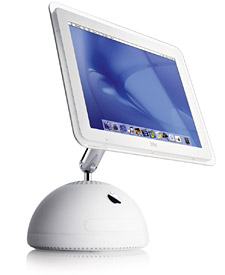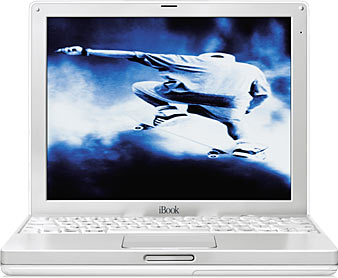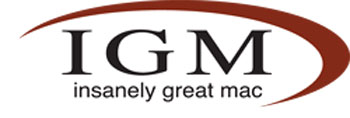Does the iBook Still Make The Grade? LCD iMac v. iBook
April 19th 2002
Contemplating an iBook purchase? Stop. Think. Since January this year, the whole ball game has changed. No longer can the differencesbetween Mac consumer desktops and portables be measured in mere megahertz.
Unless you've been living in a cave (and I know at least one of you has been), you know that the iMac now comes not only with a 15" LCD and a revolutionary new design, but it's also equipped with a G4 processor that leaves a G3 for dead - where it counts: in OS X.
If that weren't enough, the high-end iMac 800 delivers a DVD-R SuperDrive at a price that puts it line-ball with the 14.1" Combo drive iMac G3/600. The question is, which model are you going to dump your dough on?
Now, you might say, this isn't a fair comparison: the iBook is a portable. Portables are always less well-equipped and more expensive than desktop models. Fact of life. Maybe that was true a few years ago, but is less so now. Portables' hard drives, RAM, LCDs and other components have decreased dramatically in price.
But that misses the point. The iMac and iBook are now within around $100 of each other, model-for-model.
Small business, schools, consumers, prosumers: all should take the LCD iMac very, very seriously. It may halt the critical mass of Mac users drifting to portables The DVD-R models provide literally gigs of data storage, when you use the DVD-RW capability with Toast or Discribe.


iMac iBook CPU G4 @ 700 or 800MHz G3 @ 500 or 600MHz System bus 100MHz 66 or 100MHz Hard drive 40 or 60GB 15 or 20GB RAM/Maximum 128 or 256MB/1GB 128 or 256MB/640MB Display 15" LCD 12.1" or 14.1" LCD Optical drive CDRW, Combo CDRW/DVD-ROM or DVD-R/CDRW CD, DVD-ROM, CDRW or Combo DVD/CDRW FireWire Two 400Mbps ports One 400Mbps ports USB Three 12Mbps ports Two 12Mbps ports VGA/AV out VGA out - mirror mode only* VGA, composite out - mirror mode only* Audio Analog out - single speaker or Harmon Kardon external stereo speakers; 16-bit I/O Analog out; two built-in stereo speakers; 16-bit I/O Expansion slots Internal Airport card ($99) connector Internal Airport card ($99) connector Price $1,399-$1,899 $1,199-$1,799
* Note no support for legacy Apple monitors.
Now, for the first time, an iMac is actually more expensive -significantly more expensive than an iBook. But what it tells us is that the Luxo iMac is now a qualitatively different machine from the iBook: a better-equipped, higher-performing Mac that is more directly comparable to the base Power Mac G4/800.
Prices/equipment
A base iMac costs more - some $200 retail - than the entry-level iBook, but what do you get? A substantially larger 3" of LCD real estate; an 8x CDRW built in, versus a tired old CD-ROM; and a 100MHz system bus,compared with a lethargic 66MHz bus on the iBook.
But the real jam is in the high-end models: while the high-end iBook boasts a Combo DVD/CDRW drive at a price that was the envy of the PC industry on introduction last year, the DVD-R SuperDrive on the top-of-the-line iMac brings unprecedented features to the consumer Macintosh. Even the cheaper Power Mac G4/800 doesn't get this type of equipment, while you would have been up for big $$ had you wanted a SuperDrive-equipped Mac only last December.
While RAM specs are closer, the iMac takes up to a gig of RAM (important for people using the iMac for more professional work), while the iBook is dwarfed by the iMac's much higher-capacity hard drives. While 2.5" drive prices have fallen, they haven't tumbled as spectacularly as 3.5" IDE drives.
The $1,799 iBook/14.1" closes the specification gap with the iMac somewhat; it's a larger, more expensive 'Book than its smallers iblings, and it sacrifices some portability for a display that's easier on the eyes with an hour more battery life. You might think it's a lot of cash for an extra 2", but think back to how much Apple ravaged your credit card when you ordered a 14.1" Wallstreet instead of a 12.1" model.
Performance
Not to mention processors: for some, the G3 is dead. Yesterday's news, only supported by Apple in consumer models until Motorola can get the G4 running at sufficient clock cycles to bump the iBook into PowerBook G4 territory. But get this: the iMac delivers a 700MHz G4 for a mere $1,399. Even without a SuperDrive, it's a serious CPU in abasic consumer model.
While the iBook's 500 and 600MHz CPUs function more than adequately,they're not compelling performers under OS X and there is no way of getting iDVD or DVD Studio Pro working on a G3. Compare that with the G4 iMac, which opens up all sorts of possibilities with Final Cut Pro, Cleaner, Photoshop and other AltiVec applications
In other words, the iMac has gone Prosumer by default, while the iBook is strictly consumer. This isn't to belittle the iBook; it merely means that enterprise markets and smaller graphics/publishing/small-business customers who might've only been able to afford a high-end Power Mac can now realistically consider two G4 iMacs for the same price as the Power Mac. Not a bad place to be at all.
The iMac's GeForce2MX graphics card also shames the antique performance of the iBook's now-embarrassing ATI Rage 128. The 128 is really the base graphics chipset for running OS X in any acceptable way, sporting a mere 8MB VRAM. The 32MB GeForce is an entirelydifferent animal, and the frame rates on graphics-heavy games on the iMac will leave the iBook choking in its dust.
But the bottom line is that that big, fat G4 counts when you're in OS X. If you or your business has switched from 9 to X, then the iMac is a relative bargain.
Design
Two entirely discrete schools of thought here: the iBook clearly follows the traditional keyboard-forward approach pioneered by Applea nd Sony with the 1991 PowerBook 100. Not much has changed in Apple notebook design, although the iBook deploys considerable screen spaceand power in a small, light package.
Some have criticized the 14.1" iBook for being ungainly, a bastard child of the original 12.1" concept. It's heavier and larger, while providing the same size keyboard as the older model. The attractiveness of the 12.1", say the critics, is its portability and light weight; its rearticulation of the Duo concept, without the clumsiness and forced compromises of the Dock solution. The 14.1", they say, spoils this.
I disagree, but then again, 5.9lbs for the 14.1" is the same as my Lombard, and that doesn't worry me. The extra 2" of LCD is worth it to me as well. Plus, it doesn't hurt when you buy the 14.1" that it's fully loaded with all the good stuff, like the DVD/CDRW and a kick-ass battery life. And I betcha the resale will be better because of it too.
The iMac is a revolution in computer design, although perhaps not as revolutionary as Apple is making out. Even more than the iBook, the iMac's screen can be placed literally almost anywhere you want. Anywhere. Like the iBook, its viewing angles are good for an LCD (andits base is clearly engineered to accommodate future 17" or largerLCDs). The iMac screen can be swivelled to display to an audience, pushed away at will and readjusted to the finest angles. For users who suffer from back, neck or eyestrain, it's the best news sincethey invented a tonic for rheumatism.
The iMac portable? Not so's you'd notice. Oh sure, you can lug it from room to room, but gimme a break. The LCD iMac's less portable than a Color Classic (but probably more desirable).
Apple make a point of showing iMac ads without keyboard, mouse or,indeed, any visible form of electrical power. But the fact is, you'regoing to have cables snaking out the back, but at least it's easy toswivel around and plug things in. The new design does free up desk space, however, to the extent that the old iMac looks monstrous.Plus, you don't have to have the LCD iMac directly in front of you; the screen can be, but the centre of your work space can be clear,while the iMac sits off to the side. This is surely a better solutionthan the LCD-equipped PCs: a huge beige box on the floor under the desk with the floppy and CD-ROM well out of reach. What a mess.
The winner of this category is highly subjective and completely open to personal preference. Users of previous Macs will appreciate the iMac's small footprint and remarkably agile display. PowerBook and iBook aficionados will pooh-pooh the concept and argue that they've been able to put the LCD wherever they want for over a decade. And, they will say (because that is the kind of people they are), you still can't use the iMac on the couch or on the deck.
Score? Dead heat.
Hunka hunka burnin' discs
DVD-R on the iMac 800 is indeed big news, but let's buy some perspective here: we're only talking the high-end model. Mere mortals must make do with a CDRW on most models. Same goes for the iBook. And snooty G4 owners, even of the 350MHz flavor, will snipe, "Ha. I can get a Pioneer AO-3 DVD-R exactly like the SuperDrive for $299from Cheap Eddie's." True enough. They can also buy DVD Studio Pro(1,000 bucks) to go with it, but they can't buy iDVD, which Apple puts on DVD-R Macs for free. Sorta. But all that misses thepoint.
The point is that both the CDRW iBooks and DVD-R iMac are tightly integrated and let Complete Amateurs burn an audio CD with iTunes, or build a baby video with little or no prerequisite experience with CD burning or DVD movie making. Try that with a beginner on your Windows box. Not a chance in hell.
But the fact is, CDRWs are très passe, dear friends.Every Mac and his Clarus has one and no one's impressed anymore (except your friends who want you to burn all their MP3s for them). But throw 'em a DVD of your latest 18-minute film project that theycan play on their home DVD, and suddenly you're de rigeuragain. If iMovie opened up the market for an entire new generation of film-makers - some of whom will be or already are tomorrow's pros - then a DVD-R and iDVD make Hollywood or Cannes one big step closer.And all for $1,899 (and a troupe of volunteer actors) and a FireWireDV cam you, uh, "borrowed" from work.
Put it this way: CDRs are back-up storage; DVD-Rs are a whole different league altogether.
The LCD Equation
"The CRT is officially dead," said Steve Jobs at the LCD iMac'sJanuary intro. Let us dance on its grave, I say. 20 years from now,we'll probably all be suing our previous employers for damaged vision in the '90s and 2000s as they forced us to spend 8 hours per day infront of a CRT (except my employer: I use my PowerBook at work, dammit).
And not a day too soon. You'd have to slurp 5 liters out of the water cooler as an antidote to the hydration-sapping, red-eye inducing energy of the CRT monitor. Ever get bad headaches from using a CRT? Now you know why. An LCD will do wonders for your eyes and your temples, a fact I discovered in 1995. Your productivity will increase. Truly. Isn't that what it's all about?
Yes, CRTs can be essential for color-critical work, but no one's stopping you hooking up a VGA monitor to either an iBook or an iMac, are they? Yes, 17" and 19" CRTs are cheap - but there's a reason for that, isn't there?
Durability
A hot topic, this, which cooked education-focussed newsgroupswhen the flat-Mac was announced. Can the LCD iMac survive and prosperin the rigors of the classroom or lab?
No, LCDs aren't as scratch or vandal-resistant as CRTs. True. A schoolbag swung in anger might total an LCD. But on the flip side, notebooks' LCDs have proven pretty tough in general usage, althoughclosing them and then dropping them helps a lot. The chromed stainless-steel arm of the iMac demonstrates some heavy-duty engineering, but there's no way of protecting the LCD without resorting to some kind of cover. I'm not convinced that kids will put their fist through the screen though. Unless it's deliberate.
The toughness of the iBook is already the stuff of legends, although some evidence points at the exposed ports as vulnerable to catching in bags. Too early to tell, but the iBooks have demonstrated the durability of their predecessors - the fruity iBooks - so far. Come to that, if there's one Mac model I haven't heard durability complaints about, it's the fruity iBook. Hm...
Endgame
So, on a dollar-for-dollar basis, does the iBook still cut the mustard?
No.
The iMac has it all over the iBook. Maybe not on entry price, but in terms of screen real estate, G4 power, DVD-R and just flat-out cool, the iMac shows up the iBook's consumer lineage and blows any pro pretensions the iBook might have out of the water.
As OS X is now preinstalled on all Macs, the cleavage dividing the G3 and G4 is now even wider, as the G4 outperforms it by a wide maring in X.
That's not to say the iBook's bad: all it means it that it is finally beginning to date as it approaches its first birthday. We don't compare the iBook with Wintel notebooks, because the Dark Side is not where innovation lies. We compare Apples with Apples, and even with the $100 iMac price rise, the iBook is beginning to look seriously underequipped.
The solution? A G4 iBook obviously, possibly with an internal orexternal FireWire DVD-R option. But until Apple can build a PowerBookG4 with an 800 or 933MHz clock, only then will we see, say, a 550 or 667MHz iBook G4. There will not be a repeat of the iBook 466 fiasco, where Apple lost sales of the Pismo PowerBook G3/400 to the significantly-cheaper, but comparably-performing iBookSE/466.
So, if you're considering an iBook, give the iMac one long, hard look. Even the base G4/700 will halve the hours needed to encode MPEG-1 video (VideoCD). Its performance will also trump even the mighty PowerBook G4/667, costing more than a grand more.
That's progress.
